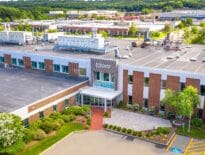
A pair of transit megaprojects could be in line for funding under the Biden administration’s proposed $2 trillion infrastructure bill.
Forget about all those cranky Republicans in Congress, with their ability to coherently debate anything, let alone a complex infrastructure bill, undermined by the whack jobs in their ranks.
Rather, the biggest threat to President Joe Biden’s $2 trillion plan to overhaul our nation’s creaky infrastructure could come within his own party as various Democratic power brokers scramble, seeking billions for their favorite pet projects.
And leading the charge is none other than U.S. Rep. Seth Moulton, last seen in public backing in unsuccessful coup attempt to replace Nancy Pelosi as House Speaker.
The outspoken North Shore Democrat has earned the distinction of pushing not one, but two potential cash-devouring boondoggles: a state-spanning high-speed train that could cost tens of billions of dollars to build, and an uber–expensive rail tunnel underneath downtown Boston.
Not as Advertised
Moulton was soaring with the eagles the other day in an interview on local public radio, expounding upon Biden’s infrastructure plan and how it could provide billions to not only build the East-West Rail line from Boston to Pittsfield, but also connect the commuter rail systems to the north and south of Boston through a downtown tunnel.
That’s a tall order.
But as he made his case for investing in high-speed rail, Moulton crossed the line from what could charitably be called visionary proposals to indulging in claims that on closer inspection, are simply outlandish.
Moulton waxed poetically in the WBUR interview about a future in which bullet trains will race across Massachusetts at hundreds of miles per hour thanks to money from the Biden infrastructure plan.
“We can put a ton of money into 1950s highways,” he said, “Or you could be zipping across Massachusetts and zipping across the entire region at 250 mph in a high–speed train.”
There’s a big problem with that claim. The most expensive option on the books for the East-West comes with a top speed of only 150 miles per hour and a walloping price tag: $25 billion.
The more pedestrian proposals that are now being considered range from $2.4 to $4.6 billion and call for speeds comparable to getting in your car and driving down the Turnpike thanks to all the twists and turns that make a true, Japanese-style bullet train infeasible.
Moulton also used his airtime to plug his other pet project, the North-South Rail Link, a decades-old proposal to bore a tunnel underneath downtown Boston to connect North and South stations.
Like the East-West rail link, there would certainly be pluses to connecting the two stations, which would finally make it possible to take a train from the North Shore straight through Boston to the South Shore and back again.
But here again, Moulton has downplayed the costs of this miniature Big Dig to the point of stretching credulity, arguing previously the project could be done for a mere $2 billion.
That’s compared to the $12 billion to $21 billion price tag the Baker administration once put on the project.
Do the Math
These numbers just don’t add up.
Biden’s infrastructure bill calls for $80 billion to be spent nationally on inter-city rail.
Spending $25 billion and on a high–speed rail service connecting Western Massachusetts with Boston, and another $21 billion on a North-South Rail Link, would gobble up over half of what Biden hopes to offer.
Given we live in a country with 49 other states, each with their own infrastructure challenges, that’s a nonstarter.
Even if you work low-ball it and go with the numbers Moulton has been using, you still come up a cost of $5 billion to $6 billion for the two projects – still a pretty big chunk of federal largesse for a single state to claim.
Are They Worth It?
But just as importantly, would the cost be worth it to build these two ambitious rail projects, whether it’s $6 billion or $46 billion?
Before the pandemic, there was a strong case to be made for rolling out an East-West Rail line in some form.
Greater Boston has enjoyed unprecedent prosperity over the past four decades, even as Western Massachusetts has struggled economically in the shift to a post-industrial economy.
So, linking the two regions on rail would make sense, or so the argument went, connecting Western Massachusetts with a booming Greater Boston while opening up more affordable housing options to buyers priced out of the eastern half of the state.
I made that case in these pages, too.
But the pandemic has turned the world upside–down, especially the world of work.
And while Boston offices aren’t about to go the way of the Lawrence textile mills, remote work is here to stay.

Scott Van Voorhis
In fact, a sizeable number of professionals have embraced the freedom of being able to work from anywhere to move to regions like Western Massachusetts, where homes have historically been much cheaper and the scenery much better.
The influx of buyers has dramatically boosted prices and unleashed bidding wars for a dwindling pool of homes from Springfield to the Berkshires.
That, in turn, has undercut at least one big part of the rationale for building a multibillion-dollar East-West rail link: These workers won’t need to travel back and forth to Boston on a regular basis in the age of Zoom.
And the same dynamics would obviously have an impact on potential demand for a rail system connecting the North and South shores, the key objective of the North-South rail link.
Sorry, Seth. Our country desperately needs an infrastructure reboot, not big, showy and impractical megaprojects like faux bullet trains and expensive tunnels underneath downtown Boston.
Scott Van Voorhis is Banker & Tradesman’s columnist; opinions expressed are his own. He may be reached at sbvanvoorhis@hotmail.com.





